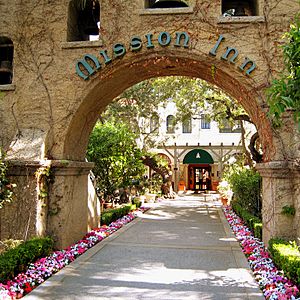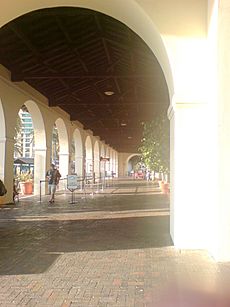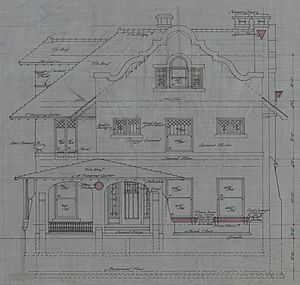Mission Revival architecture facts for kids
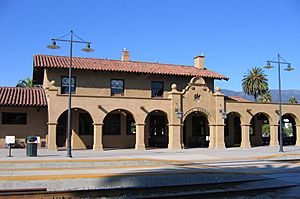

The Mission Revival style is a type of architecture that started in the late 1800s. It brought back and changed the look of old buildings from the late 1700s and early 1800s. This style was inspired by the Spanish missions in California. Sometimes, people call it California Mission Revival, especially when it's used in other places like New Mexico or Texas. These states have their own unique building styles.
This building style was most popular between 1890 and 1915. You can see it in many homes, shops, and public buildings. Schools and train stations were often built in this style.
Contents
What Inspired Mission Revival Buildings?
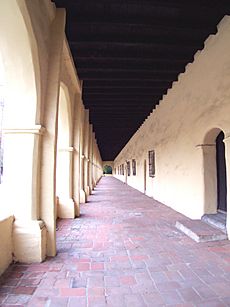
The 21 Franciscan Alta California missions, built from 1769 to 1823, all looked quite similar. This was because the missionaries who built them came from the same places in Spain and Mexico City. They copied the Spanish Colonial style they knew.
Also, they had limited building materials, mostly adobe (mud bricks). They didn't have many choices for design. The missionaries and the local people also had basic building skills. This meant they had to keep the designs simple.
What Do Mission Revival Buildings Look Like?
Features of the Original Missions
The original missions were built for safety and practicality. They often had a central courtyard surrounded by buildings. Their walls were very thick, made of adobe, and covered with smooth plaster (stucco).
They had few windows and doors. The roofs were low and wide, with large eaves that hung over the sides. These roofs were covered with fire-resistant clay tiles. Strong arches supported by thick pillars were also common. The white stucco walls and wide eaves protected the adobe bricks from rain.
Other features included long outdoor arcades (covered walkways with arches). Inside, rooms often lined up one after another. Some missions had special bell-gables (walls with openings for bells) or curved gables on the front.
How the Revival Style Copied Them
The new Mission Revival buildings copied these old features. They used different amounts of these elements and sometimes changed them a bit. At the same time, people in California realized the old missions were falling apart. There was a desire to restore them.
People also felt a sense of nostalgia for a "simpler time" as California changed quickly. The popular novel Ramona helped make this feeling stronger. Today, builders use modern materials and follow earthquake safety rules. So, many of the old structural parts are now just for looks. But things like tile roofs, shaded walls, and outdoor arcades are still useful.
The Mission Revival style, and later the Spanish Colonial Revival style, became very popular in the Southwestern United States. They fit the history, culture, and climate of places like California very well.
Where Can You See Mission Revival Buildings?

The Mission Inn in Riverside, California, is one of the biggest Mission Revival buildings in the United States. It has been restored, and you can take tours to see its unique style.
Here are some other buildings designed in the Mission Revival Style:
- Castañeda Hotel in Las Vegas, New Mexico, opened in 1899. It was the first Mission Revival building in New Mexico.
- Santa Fe Depot in Las Vegas, New Mexico, finished in 1899.
- Alvarado Hotel and Santa Fe Depot in Albuquerque, New Mexico, finished in 1902. The hotel was torn down in 1970.
- Arrowhead Springs Resort & Hotel in the San Bernardino Mountains, California, built in 1939.
- Brophy College Preparatory in Phoenix, Arizona.
- Ponce De Leon Hotel in St. Petersburg, Florida, finished in 1922.
- Caliente Railroad Depot in Caliente, Nevada, finished in 1923.
- The Mary Louis Academy Chapel in Jamaica Estates, New York, finished in 1937.
- California Baptist University in Riverside, California, original buildings from 1921.
- Davis Amtrak station in Davis, California, finished in 1914.
- Elizabeth Bard Memorial Hospital in Downtown Ventura, California, finished in 1902.
- Four Roses Distillery in Lawrenceburg, Kentucky, built in 1910.
- Francis Lederer estate and home in West Hills, Los Angeles, finished in 1936.
- Iao Theater in Wailuku, Maui, Hawaii, built in 1928.
- Kelso Depot in the Mojave Desert, California, finished in 1923.
- Los Angeles Herald-Examiner Building in Downtown Los Angeles, built in 1915.
- Los Angeles Union Station, which mixes Mission Revival with other styles.
- Santa Fe Railway Depot in San Juan Capistrano, California, finished in 1894.
- San Gabriel Mission Playhouse in San Gabriel, California, finished in 1927.
- Southern Pacific Railroad depot in Burlingame, California, finished in 1894.
- Santa Clara University in Santa Clara, California.
- Stanford University, main quad, in Stanford, California, finished in 1891.
- Texas A&M University–Kingsville in Kingsville, Texas, founded in 1925 with new buildings in this style.
- Santa Fe Depot in San Diego, California, finished in 1915.
- Valdosta State University's Main Campus in Valdosta, Georgia.
- Villa Rockledge in Laguna Beach, California, finished in 1935.
- Louis P. and Clara K. Best Residence and Auto House in Davenport, Iowa, built 1909–1910.
- Several buildings at Montclair State University in Montclair, New Jersey, starting in 1908.
- Several buildings at Queens College in Queens, New York, including Jefferson Hall, built in 1907.
- Eleven railroad stations built from 1926–1929 by architect Arthur Gerber in the Chicago suburbs and two in Northwest Indiana. The Beverly Shores, Indiana station is a great example.
- The Main Building at Auckland Grammar School in Auckland, New Zealand, built in 1916.
- St. Mark's Episcopal Church, Berkeley, California, built in 1902.
- Many Catholic churches in the southwestern United States also use parts of this style.
See also
 In Spanish: Estilo Misión para niños
In Spanish: Estilo Misión para niños


